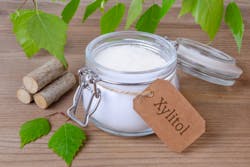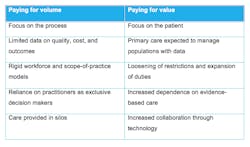"IN 2005 I LOST MY BEST FRIEND of 35 years to metastatic breast cancer. I was her caregiver and advocate throughout the process. She experienced agonizing mucositis during her treatment, and as a hygienist I felt like I could have—should have—been able to do more to improve her situation."I lost an uncle to esophageal cancer and a brother-in-law to recurrent oral cancer. I am a survivor of breast cancer who experiences pretty severe xerostomia due to preventive medications. "The market has changed so much and we have so many more options available than we did 10-plus years ago. I feel compelled to bring this information to the public. Every day we have patients in our chairs who are in treatment, who are survivors, or who are the friends, family members, loved ones, or caregivers of those who are." –Kris Potts, RDH |
My journey started more than six months ago.It began as an asthma flare and turned into something quite different. The diagnosis? Hypersensitivity pneumonitis with more than $19,000 in medication costs in just six months.
Dental hygienists are preventive specialists, yet much of the care we offer is after symptoms occur. For Kris, for her friends and family, and for me, we need to start practicing prehabilitation.
Velcro mouth
I continue to practice as a clinician to stay grounded in the reality of patient care. Like most dental hygiene professionals, I love my patients.
My patient Connie had been diagnosed with multiple sclerosis 20 years before I met her as she slowly shuffled her walker into my treatment room. Her story is long and complex. Connie and I bonded immediately. At the end of the first appointment, she took my hand and said, “God is taking my legs, can you help me keep my teeth?”
Over the years, Connie lost the ability to use her legs and much more. Her medication list reads like a thick book. She said her primary quality-of-life issue was not her loss of mobility—she had even figured out how to garden from her scooter!—but her dry mouth. She said her tongue and palate were like two halves of Velcro. Every time I saw her, we adjusted her dry mouth plan because, like every one of our patients, her health was not static. Life is dynamic and ever-changing, and our care plans should be too.
Not a single product on the market today can solve all the oral issues our patients face. What works well for one does not necessarily work well for another, and needs change during the course of treatment. An important part of any plan includes xylitol products.
By this time, you have probably read articles, taken classes, and been introduced to benefits of xylitol. Xylitol was originally used as a natural alternative to sugar with its one-to-one sweetness ratio. It has virtually no effect on blood sugar and insulin levels. It also has 40% fewer calories than sugar. (1) Xylitol also moistens and soothes skin by pulling water to the skin surfaces. (1)
One of the greatest benefits of xylitol is how it interacts with bacteria. Xylitol is nonfermentable. (2) In other words, it can't be metabolized by bacteria, which results in bacteria not being able to thrive or produce their byproduct: harmful acids. (2)
Xylitol's antiadhesive quality reduces bacteria's ability to adhere to cell tissue and fluorish. (2) This is beneficial for Connie and other at-risk patients because we don’t want to add more chemicals and drugs to an already thick book of medications.
Xylitol research controversies
A 2011 Cochrane Review published in the Journal of the American Dental Association described less exciting results for xylitol. (3)
Of the 915 research articles published about xylitol, the review only included 10 studies. (1) These systematic reviews require that all studies be randomized, double-blind, and placebo-controlled. This conclusion is confusing because many evidence-based studies have shown that xylitol works. Go to Google Scholar and type in "xylitol" and "caries," and you will see 300-plus studies showing xylitol’s effect at preventing and reversing caries infections.
So why the discrepancy? The problem is the lack of proper education and application. Xylitol expert Ellie Phillips, DDS, and lecturer Graeme Milicich, BDS, both agreed that the results did not surprise them. (4) “Water can put out a fire, but a cup of water is not going to deal with a house fire," said Dr. Milicich in a comment to Dr. Phillips. (4) "The people selected [for] this study were high-risk patients, so throwing a cup of water at the problem, without any other intervention, is obviously not going to deal with it.” (4)
The patients in this study had serious decay problems, and many were already missing half of their teeth. They experienced about four new cavities a year, yet it does not appear that anyone addressed their lifestyles or other risk factors. Dr. Phillips put it this way: “This study used xylitol without any education, which is similar to giving a couple of diet pills to obese patients without any dietary advice and then being shocked that they didn’t work!” (4)
Prehabilitation
Prehabilitative anticipatory treatment plans are the key to success.
Health-care costs continue to skyrocket. Although many solutions are being offered, almost everyone can agree these costs are unsustainable and change is needed. This includes moving our payment systems away from paying for volume—that is, the sicker someone is, the greater the compensation—to paying for value (table 1). (5)
Table 1: Role of value-based reimbursement in the dental safety net (5)Prehabilitation is one way to move away from sick care toward health care. Prehabilitation is a process designed to improve a person’s physical and psychological health in anticipation of an upcoming stressor. It occurs after diagnosis but before treatment. It is a proactive approach, not a reactive approach. (5)
It is unclear when the term prehabilitation was first used. Medical professionals, researchers, and public health experts have placed more emphasis on the prevention of diseases and injuries in the past few decades as more evidence has accumulated, which may have led to the development of prehabilitation.
In a well-intended online instructional guide, titled "Prehabilitation for Surgery Patients," the entire section on oral care reads: “Oral hygiene—Use mouthwash and brush teeth twice daily for two days before surgery to reduce harmful bacteria in the mouth and reduce chance of pneumonia.” (6)This is not bad advice necessarily, although it is minimal and short-sighted.
In recent years, the body of scholarly research on prehabilitation has grown exponentially. While long-term results vary from patient to patient, oral health prehabilitation shows great promise. For dental hygienists who are preventive experts, comprehensive prehabilitation is easy to understand and implement.
Prehabilitation expertise
We have many options for creating individualized patient care plans. What we need are experts to guide us and other health professionals so that we can provide better care for our patients. Kris Potts, RDH, is an oral health prehabilitation expert. Google "prehabilitation oral health," and you will find articles by her, as well as numerous scholarly articles.
Potts is the owner and CEO of Oral Health Promotion Strategies LLC. Fired up by personal experience with friends, family, patients, and her own health challenges, she has years of clinical experience and offers educational speaking, writing, and coaching services to dental and medical professionals.
Her work doesn't take a cookie-cutter, one-size-fits-all approach because one size does not fit all. She helps professionals learn to develop anticipatory treatment plans that include xylitol. One of her favorite questions to ask those seeking product recommendations is, "What are you trying to achieve?" or "What is the goal?"
Below is a sample of a customized prehabilitative anticipatory treatment plan for a patient named Laura. Potts designed this program specific to Laura’s needs, wants, conditions, and dental-medical necessity. Dental-medical necessity is important to Laura because she has both dental and medical benefits that may cover this care. It is not a one-size-fits-all treatment plan. As you can see, a variety of diagnostics are needed, as well as in-office treatment, home care, and measures for prevention and symptom relief.
Sample prehabilitative anticipatory treatment plan
Laura is a 45-year-old woman recently diagnosed with small stage II invasive ductal carcinoma in the left breast. SMX in two weeks, followed by chemotherapy to begin two weeks after surgery. Patient of record, fairly regular preventive appointments, does not floss consistently, slight generalized gingivitis with localized BOP, localized CAL, slight sensitivity to cold, multiple existing restorations, mild existing polypharmacy-induced xerostomia, anxiety.
In-office care (partial treatment plan)
- Comprehensive oral evaluation including perio charting
- Full series intraoral radiographic images
- Fluorescence screening for caries (Air Techniques CamX Spectra)
- Fluorescence screening for inflammation (Acteon SoproCare)
- Caries risk assessment (CariFree)
- Saliva testing (GC America Saliva-Check Buffer)
- Incipient caries infection treatment fluoride disks (Phocal)
- Fluoride varnish (GC America MI Varnish)
- Oral hygiene instructions
- Behavior management
Home-care recommendations
- Home pH testing (pH2OH)
- Extra-soft surgical toothbrush (Curaprox CS Surgical Mega Soft)
- Gentle interdental brushes (Curaprox CPS Prime)
- Water flosser on low power (WaterPik)
- Mouth rinses (Xlear Spry Alcohol-Free Mouthwash)
- Rx toothpaste (GC America MI Paste One)
- Trays to deliver remineralizing medicaments (GC America MI Paste)
Prevention and symptom relief
- Xylitol to balance pH (Xlear Spry Lemon Crème or Berry Xylitol Gems)
- Daytime moisture (Xlear Spry Rain Oral Mist)
- Overnight (Xlear Spry Tooth Gel)
Author's note: You can go to Kris Potts’s website for product lists. For information on coding, contact Patti DiGangi.
More than a list
Wouldn’t it be great and so very easy to have this plan printed out so you could hand it to a cancer patient? The answer is no. It might be easy but it wouldn't be effective. As Dr. Phillips said, recommending oral care products without any education is similar to giving diet pills to obese patients without any dietary advice, then being shocked that it didn’t work. We all need customized treatment plans that include what we can and will do to improve our health.
As dental hygienists, we have an important role in meeting the unique and often challenging needs of our patients. Our position on the health-care team gives us an opportunity to discuss treatment-related outcomes, provide targeted interventions, and positively impact patients' quality of life. We can also assist in educating other health-care professionals because wherever their areas of expertise may be, our area of expertise is the oral cavity, and we can be a valuable resource to them.
Editor's note: This article first appeared in Pearls for Your Practice: The Product Navigator.Click here to subscribe. Click here to submit a products article for consideration.
References
1. O’Hehir T. Xylitol: The biggest game changer for dental hygiene. Spear Education website. https://www.speareducation.com/spear-review/2016/01/xylitol-the-biggest-game-changer-for-dental-hygiene. Published January 19, 2017. Accessed July 16, 2017.
2. What is xylitol? Xlear website. http://www.xlear.com/what-is-xylitol. Accessed July 2017.
3.American Dental Association Council on Scientific Affairs. Non-fluoride caries preventive agents: Full report of a systemic review and evidence-based recommendations. ADA Center for Evidence-Based Dentistry. http://ebd.ada.org/~/media/EBD/Files/clinical_recommendations_non_fluoride_caries_preventive_agents_full_report.pdf?la=en. Published May 24, 2011. Accessed July 18, 2017.
4. Phillips E. Xylitol in the news: Reading beyond the headlines. Dr. Ellie website. https://drellie.com/2013/01/28/xylitol-in-the-news-reading-beyond-the-headlines. Published January 28, 2013. Accessed July 17, 2017.
5. Glassman P, Stengis A. Role of value-based reimbursement in the dental safety net: What CHC dental practices should know about trends in accountable oral healthcare. University of the Pacific Arthur A. Dugoni School of Dentistry Pacific Center for Special Care.http://www.nnoha.org/nnoha-content/uploads/2015/12/Role-of-Value-Based-Reimbursement-in-the-Dental-Safety-Net.pdf. Published December 2015. Accessed April 24, 2017.
6. Jacob A, Schneider A. Prehabilitation for surgery patients. Henry Ford McComb Hospital website. http://web2.facs.org/download/Alisa-Jacob.pdf. Accessed July 16, 2017.









